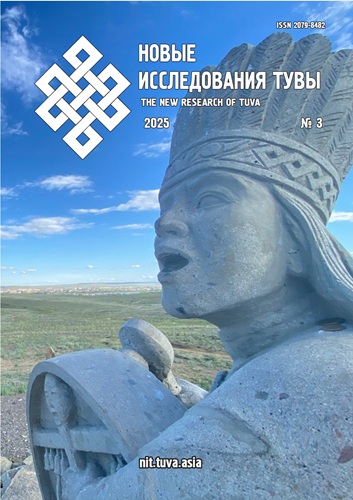Common Turkic Ornithonyms in the Tatar and Tuvan Languages (Ethnolinguistic Aspect)
DOI:
https://doi.org/10.25178/nit.2025.3.21Keywords:
Tatar language; Tuvan language; Turkic language; ornithonym; bird name; Old Turkic term; nomination; paremiologyAbstract
This article presents a comprehensive analysis of ornithonyms in the Tatar and Tuvan languages from the perspectives of lexical-semantic and linguocultural features, semantic flexibility of the lexical units denoting birds, and their potential to represent the traditional linguistic worldview. Tatar and Tuvan bird names are studied here for the first time in a comparative-contrastive, historical-semantic, and ethnolinguistic context. The research material comprises lexicographical and scientific sources, collections of folk literature, and the rich speech practices of both languages.
The pathways of dissemination of Tatar and Tuvan ornithonyms into other related and unrelated languages are demonstrated; symbolic meanings of bird names are identified; folkloric traditions of using ornithological connotations and symbolism are examined.
A detailed description is provided for Tatar and Tuvan bird names such as crane, raven (male), crow (female), eagle/golden eagle, falcon, hawk, and duck, as well as for the hyperonym “bird”. These ornithonyms are endowed with special ethnosemantic meanings among both Tatars and Tuvans.
Ornithological images are reflected in the spiritual cultural heritage of Turkic peoples largely due to the ancestral sacralization of birds, perceived as connecting the higher world with the natural world.
References
Bazarova, D. Kh. (1975) On the etymology of some Old Turkic bird names. Sovetskaya Tyurkologiya, no. 4, pp. 11–23. (In Russ.)
Bazarova, D. Kh. (1978) History of the Formation and Development of Zoological Terminology in the Uzbek Language. Tashkent, Fan. 224 p. (In Russ.)
Giniatullin, M. M. (1977) Motivation of some Turkic bird names. Sovetskaya Tyurkologiya, no. 1, pp. 38–44. (In Russ.)
Dambaa, Sh. V. and Suvandii, N. D. (2021) Hunting vocabulary in the linguistic worldview of the peoples of the Sayano-Altai region (based on Tuvan, Tofalar, Altai and Khakas languages). New Research of Tuva, no. 4, pp. 172–185. (In Russ.) DOI: https://doi.org/10.25178/nit.2021.4.13
Egorov, N. I. and Petrov, L. P. (1982) Etymology of some Chuvash ornithonyms. Sovetskaya Tyurkologiya, no. 6, pp. 64–77. (In Russ.)
Yerlenbaeva, N. V. (2019) Names of birds of prey in the Altai language and its dialects. In: Proceedings of the First Altaic Forum “Turko-Mongolian World of Greater Altai: Historical and Cultural Heritage and Modernity”: Materials of the First International Altaic Forum, Barnaul — Gorno-Altaysk, September 12–14, 2019, ed. R. I. Raykin. Barnaul; Gorno-Altaysk: Altai State University. 396 p. Pp. 58–60. (In Russ.)
Ivanov, E. E. and Mongush, Sh. V. (2023) The world of wild animals and their images in Tuvan riddles. New Research of Tuva, no. 3, pp. 65–83. (In Russ.) DOI: https://doi.org/10.25178/nit.2023.3.5
Kuular, Sh. Kh. (2020) Zoonyms in Tuvan literary tales. In: Actual Problems of Researching Ethnoecological and Ethnocultural Traditions of the Peoples of Sayano-Altai: Materials of the 6th International Scientific and Practical Conference of Young Scientists, Postgraduates and Students, Kyzyl, June 30 — July 3, 2020. Ed. by E. D. Mongush. Kyzyl, Tuvan State University. 154 p. Pp. 21–22. (In Russ.)
Kyrgys, A. A. and Chebodaeva, L. I. (2016) Names of birds of prey in Khakas and Tuvan languages. In: Actual Problems of Studying Language, Literature and Journalism: Contamination and Convergence of Humanitarian Thought: Materials of the 11th International Scientific and Practical Conference, Abakan, November 23–24, 2016. Ed. by V. P. Antonov. Abakan, Khakas State University named after N.F. Katanov. 290 p. Pp. 195–197. (In Russ.)
Kyrgys, A. A. and Chebodaeva, L. I. (2017) Names of galliform birds in Khakas and Tuvan languages. Vestnik Khakasskogo Gosudarstvennogo Universiteta im. N. F. Katanova, no. 21, pp. 70–73. (In Russ.)
Nasilov, V. M. (1960) Language of the Orkhon-Yenisei Monuments. Moscow, Vostochnaya Literatura. 86 p. (In Russ.)
Nurzet, Ts. S. B. (2023) Everyday semantics of the bionym “sparrow” in Russian and Tuvan languages (based on linguistic experiment results). In: Philology, Foreign Languages and Media Communications: Materials of the Symposium within the Framework of the 18th (L) International Scientific Conference of Students, Postgraduates and Young Scientists Dedicated to the 50th Anniversary of Kemerovo State University, Kemerovo, April 27, 2023. Ed. by E. V. Novgorodova. Kemerovo, Kemerovo State University. 446 p. Pp. 418–422. (In Russ.)
Nurzet, Ts. S. B. (2024) Everyday semantics of the bionym raven/kaargan in Russian and Tuvan languages (based on linguistic experiment materials). Languages and Literature in a Multicultural Space, no. 10, pp. 157–162. (In Russ.)
Petrov, L. P. (1982) On the etymology of Chuvash ornithonyms — I. In: Studies in the Lexicology and Phraseology of the Chuvash Language: Collection of Articles. Ed. I. P. Pavlov. Cheboksary, Chuvash NIYALIÉ. 136 p. Pp. 56–74. (In Russ.)
Rabenko, T. G. and Nurzet, Ts. S. B. (2023) Everyday semantics of the bionym eagle/ezir in Russian and Tuvan languages (based on linguistic experiment results). Nauchny Dialog, vol. 12, no. 3, pp. 82–99. (In Russ.) DOI: https://doi.org/10.24224/2227-1295-2023-12-3-82-99
Sanchai, Ch. Kh. and Kukhta, M. S. (2019) Semantics of structural elements of Tuvan dance. New Research of Tuva, no. 1, pp. 176–189. (In Russ.) DOI: https://doi.org/10.25178/nit.2019.1.1
Sanchai, Ch. Kh. (2014) “Eagle dance” — spiritual and artistic heritage of the Tuvan people. New Research of Tuva, no. 1, pp. 113–119. (In Russ.)
Safina, E. I. (2006) Names of Birds in the Tatar Language and Their Lexicography. Kazan, Dom Pechati Publishing. 160 p. (In Russ.)
Sevortyan, E. V. (1980) Etymological Dictionary of Turkic Languages: Common Turkic and Inter-Turkic Roots Starting with the Letters “V”, “G”, “D”. Moscow, Nauka. 394 p. (In Russ.)
Setarov, D. S. (1983) Turkic lexical elements in Russian names of birds. Sovetskaya Tyurkologiya, no. 3, pp. 11–21. (In Russ.)
Suvandii, N. D. (2013) Hunting vocabulary in the Todzhin dialect of the Tuvan language. New Research of Tuva, no. 1, pp. 72–78. (In Russ.)
Suleymanova, R. A. (2019) Bashkir surnames with a totemistic basis: linguocultural and etymological aspects. Voprosy Kognitivnoy Lingvistiki, no. 3, pp. 128–134. (In Russ.) DOI: https://doi.org/10.20916/1812-3228-2019-3-128-134
Erkenova, F. P. (2021) Ornithonymy in the Karachay-Balkar Language (Lexico-Semantic Aspect). Pyatigorsk, OOO “Prosto”. 616 p. (In Russ.)
Published
How to Cite
For citation:
Safina E. I. Common Turkic Ornithonyms in the Tatar and Tuvan Languages (Ethnolinguistic Aspect). New Research of Tuva, 2025, no. 3, pp. 352-370 (In Russ.). DOI: https://doi.org/10.25178/nit.2025.3.21
Issue
Section

This work is licensed under a Creative Commons Attribution-NonCommercial 4.0 International License.

Author(s) license holder(s) grant rights for their work to the journal (grantee of a license) under the simple non-exclusive open license in accordance with Art. 1286.1 «Open license for a research work, work of literature or fine arts», Civil Code of the Russian Federation.
New Research of Tuva publishes articles under the Creative Commons Attribution-NonCommercial license (CC BY-NC).
Since it is an open license, author(s) reserve the right to upload the article to their institutional repository, submit it to another journal (if it allows republications), or republish it on their own website (in full, or in part).
However, several conditions apply here:
a) The republished version must always contain the name(s) and affiliation(s) of the author(s), the original title and the hyperlink to the original version on the New Research of Tuva website;
b) It must be in open access, free of charge, and no category of readers must be in any way whatsoever advantaged over general readership.
c) should the contribution be submitted elsewhere by its author(s) without substantial modification (30% or more of original text unchanged), the body of the article should contain a disclaimer that the original version was published in New Research of Tuva (with a link to the respective page)
The CC-BY-NC is a non-revocable license which applies worldwide and lasts for the duration of the work’s copyright.









